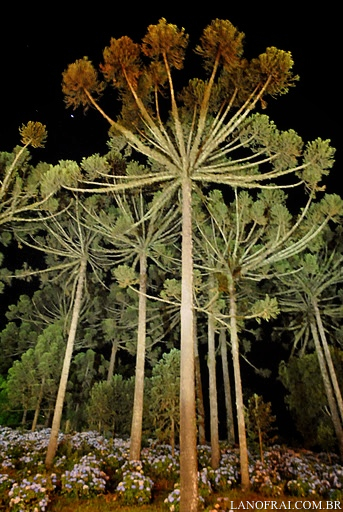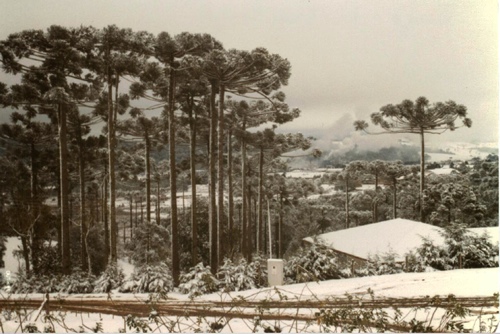Impossível passar pelo Frai sem notar as remanescentes e imponentes araucárias e suas fieis amigas cortejantes (hortências). O que me alegra é poder vê-las ainda ao vivo e das suas grimpas fazer um fogo de chão que estrala como pipoca para sapecar o pinhão.
Impossible to pass by without noticing the remaining and imponent Araucária pines and their faithful friends (hydrangeas). I’m glad they still exist provinding delicius food (seeds) called “pinhão”.

Por muito pouco nossas araucárias não foram todas extintas. Em menos de 50 anos elas foram perseguidas e aniquiladas sistematicamente num tremendo holocausto vegetal sem precedentes na nossa história. Quanto maior fosse a tora, maior era o orgulho da ignorância do homem. A americana Southern Brazil Lumber & Colonization Company era como um polvo e seus tentáculos (trilhos) penetravam no continente sugando todas as árvores e recursos naturais que poderiam ser transportados nos vagões até os portos de SP e RJ. Onde estariam essas árvores hoje? Depois da limpeza no terreno, bastava expulsar os nativos da região e vender terrenos já loteados para os europeus famintos que, no Brasil, não paravam de chegar.
Resultado,
a desabilitada estrada de ferro do planto nos custou o “despovoamento de 15 milhões de pinheiros, imbuias, cedros e perobas que se aninharam no extenso planalto de Canoinhas” Sergio Sachet – Santa Catarina 100 de história. Do gene humano que ali habitava o estrago foi incalculável.
It is just by chance they were not all extinguished. In less than 50 years they were systematically persecuted and annihilated a huge vegetable holocaust unprecedented in our history. The larger the log, the greater was the pride of ignorance of human kind. The U.S. Southern Brazil Lumber & Colonization Company was like an octopus and the tentacles (rails) penetrated the continent sucking all the trees and natural resources that could be transported in wagons to the ports of RJ and SP. Where were these trees today? After cleaning the ground, it was enough to expel the natives and sell land already batched for the hungry Europeans immigrants who could not stop coming to Brazil.
As a result,
The, nowadays, a disabled railroad costed the “depopulation of 15 million pines, walnuts, cedars and perobas that nested themselves in the extensive plateau Canoinhas” Sergio Sachet – Santa Catarina 100 history. Regarding the the human gene that lived there the damage was incalculable.


